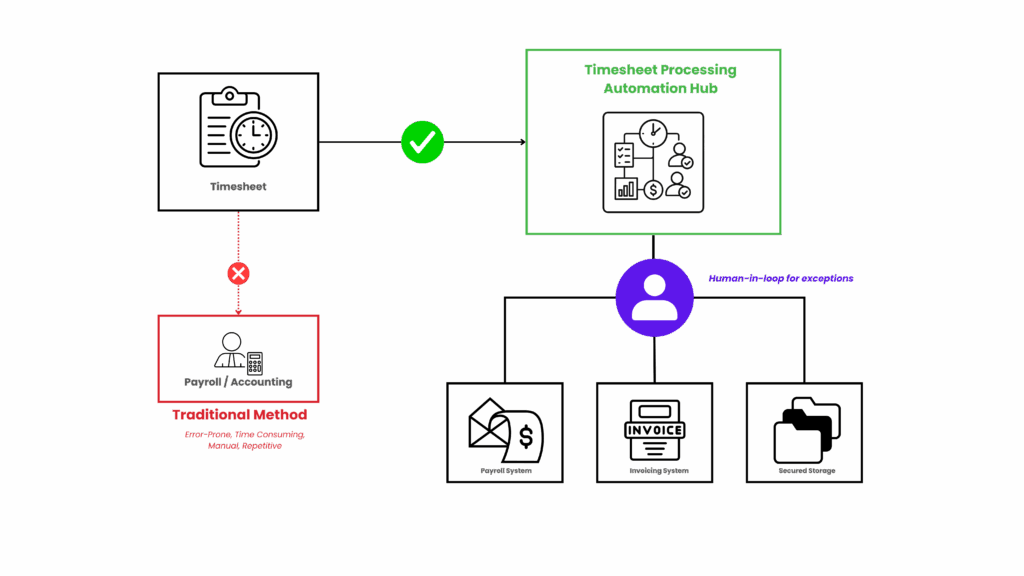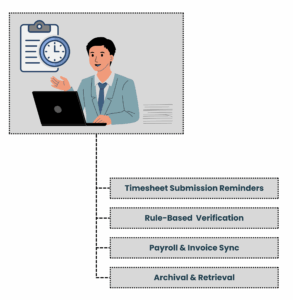
By Rehman Vallikhan, Development Manager, Zura Labs
Key takeaways:
- Timesheets directly impact revenue and cash flow: Staffing firms, especially in IT, healthcare, and professional services, rely on accurate time tracking for billing and payroll. Errors and delays in timesheet processing can disrupt cash flow, damage client relationships, and slow growth.
- Operational efficiency as a competitive advantage: Automation can free up operations teams, reduce burnout, and shift human effort to higher-value tasks — all strategic outcomes for lean staffing organizations.
- Real-time business intelligence for decision-making: Automated timesheet systems give executives real-time visibility into revenue forecasts, margins, and consultant productivity — critical levers for planning, decision-making, and investor reporting.
In the staffing industry, timesheets are a primary source of revenue. Yet, many firms still rely on outdated, manual timesheet workflows that introduce errors, delay payroll, and disrupt cash flow. This article outlines how automating key components of timesheet processing can eliminate operational inefficiencies, improve accuracy, and offer real-time business insights — freeing up operations teams and enabling leadership to make faster, smarter decisions.
The timesheet mess
Timesheets are essential for tracking consultant productivity and billing accuracy. In IT staffing, where consultants work across varied client projects, accurate time tracking is mission critical. Yet, while the process appears straightforward — submit, validate, invoice, and pay — it often devolves into a manual, time-consuming burden.
Current challenges in timesheet workflows
Common challenges that staffing companies are constantly trying to address include:
- Manual follow-ups with consultants leading to delayed submissions and inaccurate billing and payroll
- Spreadsheet based validations resulting in high error rates and non-compliance risks
- Disconnected payroll / invoicing, leading to inconsistent cashflows and poor visibility
- Lack of centralized storage with audit trail, resulting in legal / audit risk and difficulty retrieving historical data
Automating the key components
Will automation replace people? The answer is no. Automation doesn’t replace people — it replaces repetitive tasks.
Here are some key components that you can automate in your workflow for improved efficiency and reduced headaches.
| Function | Automation |
| Submission reminders | Send automated prompts to consultants based on due dates |
| Rule-based timesheet verification | Auto-verifies entries based on predefined hours, project codes, etc. |
| Payroll and invoice sync | Auto-generates payroll and billing aligned to project or client schedules |
| Archival and retrieval | Automatically stores records for audit, compliance, or analysis |

Business impact
Timesheet automation can do more than just reduce manual effort. Some of the key aspects impacted by automating workflows are:
- Timesheet submission: By avoiding the back and forth of communication, you’ll cut submission time from a few weeks to just a few hours.
- Verification errors: Due to human intervention, operations teams encounter at least 8 to 10% of timesheet verification errors, eventually leading to repeat work and burnout. With automation in place, the errors reduce to around 1%, meaning that the operations teams handle only exceptions.
- Invoicing and payroll processing: Manual reconciliation of timesheet data for invoicing and payroll normally requires a few business days. But with automation in place, the bill / pay rates are reconciled, and the processing can be achieved in one business day.
- Cashflow predictability: Timely and error-free invoicing ensures that there is improvement in cashflow predictability.
 How timesheet automation helps staffing leaders
How timesheet automation helps staffing leaders
Automation isn’t just for operations — it gives leadership a sharper business pulse. Real-time invoice forecasting helps them know revenue in advance and plan collections proactively. They will be able to better track margins / employee / project. And most importantly, they will be able to improve their customer experience and satisfaction.
Human-in-the-loop remains essential
Automation simplifies but doesn’t eliminate human oversight. Operations managers still play a key role in:
- Exception handling (e.g., irregular timesheets)
- Policy enforcement across clients
- Manual verification in flagged cases
- Liaising with clients on disputed entries
From workflow bottleneck to growth engine
Transforming timesheets from an operational pain point to a performance driver is no longer optional — it’s a competitive necessity. The future of staffing lies in operational intelligence. By automating the repetitive yet business-critical timesheet process, staffing companies unlock more than just cost savings — they gain speed, visibility, compliance, and financial agility. Firms that embrace automation today will lead tomorrow. Those that don’t risk falling behind, bogged down in inefficiencies that modern tools can easily resolve.
 Rehman Vallikhan leads the Engineering and Digital Solutions teams at Zura Labs. He holds a strong conviction that the thoughtful integration of technology and human judgment can effectively simplify and streamline complex challenges. Although he does not consider himself a prolific writer, he takes great interest in sharing his insights and perspectives to foster learning and discussion. He emphasizes that his writing is driven not by search engine optimization, but by a genuine desire to express his thoughts. Rehman values diverse viewpoints and remains open and engaged in exchanging ideas with the broader community.
Rehman Vallikhan leads the Engineering and Digital Solutions teams at Zura Labs. He holds a strong conviction that the thoughtful integration of technology and human judgment can effectively simplify and streamline complex challenges. Although he does not consider himself a prolific writer, he takes great interest in sharing his insights and perspectives to foster learning and discussion. He emphasizes that his writing is driven not by search engine optimization, but by a genuine desire to express his thoughts. Rehman values diverse viewpoints and remains open and engaged in exchanging ideas with the broader community.






